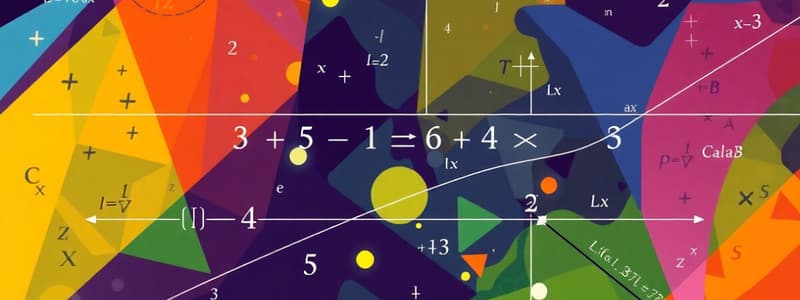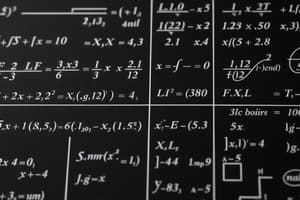Podcast
Questions and Answers
What does the limit of a function represent?
What does the limit of a function represent?
- The maximum value the function can achieve
- The value that the function approaches as the input approaches a point (correct)
- The average value of the function over a range
- The instantaneous rate of change of the function
Which rule would you use to differentiate the product of two functions?
Which rule would you use to differentiate the product of two functions?
- Product Rule (correct)
- Power Rule
- Quotient Rule
- Chain Rule
What is the primary purpose of integrals in calculus?
What is the primary purpose of integrals in calculus?
- To solve for unknown variables in an equation
- To determine the maximum value of a function
- To represent the area under a curve (correct)
- To find the slope of a curve
What characterizes an eigenvector of a square matrix?
What characterizes an eigenvector of a square matrix?
What does the Jacobian matrix consist of?
What does the Jacobian matrix consist of?
In what context is the gradient used in calculus?
In what context is the gradient used in calculus?
Which method is NOT commonly used for solving systems of linear equations?
Which method is NOT commonly used for solving systems of linear equations?
What is a primary application of eigenvalues in real-world scenarios?
What is a primary application of eigenvalues in real-world scenarios?
Flashcards are hidden until you start studying
Study Notes
Key Concepts in Calculus
-
Limits
- Definition: Value that a function approaches as the input approaches a point.
- Notation: ( \lim_{x \to a} f(x) )
-
Derivatives
- Definition: Measure of how a function changes as its input changes.
- Notation: ( f'(x) ) or ( \frac{dy}{dx} )
- Fundamental rules:
- Power Rule: ( \frac{d}{dx}(x^n) = nx^{n-1} )
- Product Rule: ( (fg)' = f'g + fg' )
- Quotient Rule: ( \left(\frac{f}{g}\right)' = \frac{f'g - fg'}{g^2} )
- Chain Rule: ( (f(g(x)))' = f'(g(x))g'(x) )
-
Integrals
- Definition: Represents the area under a curve.
- Notation: ( \int f(x) , dx )
- Fundamental Theorem of Calculus: Connects differentiation and integration.
- Techniques: Substitution, integration by parts.
Key Concepts in Linear Algebra
-
Vectors
- Definition: An ordered list of numbers, can represent points or directions in space.
- Operations: Addition, scalar multiplication, dot product, cross product.
-
Matrices
- Definition: Rectangular array of numbers.
- Types: Row matrix, column matrix, square matrix.
- Operations: Addition, multiplication, transpose, inverse.
-
Systems of Linear Equations
- Representation: Can be written in matrix form ( Ax = b ).
- Methods of solving:
- Substitution
- Elimination
- Matrix methods (e.g., Gauss-Jordan elimination)
-
Eigenvalues and Eigenvectors
- Definition: For a square matrix ( A ), eigenvector ( v ) satisfies ( Av = \lambda v ), where ( \lambda ) is the eigenvalue.
- Applications: Stability analysis, principal component analysis.
Interrelation of Calculus and Linear Algebra
-
Gradient
- Represents the direction and rate of steepest ascent in multivariable functions.
- Notation: ( \nabla f )
-
Jacobian Matrix
- Matrix of all first-order partial derivatives of a vector-valued function.
- Important in multivariable calculus for transformations.
-
Optimization
- Use gradients and Hessians (second derivatives) in linear algebra to find maximum and minimum values of functions.
-
Differential Equations
- Often involve linear algebra when solving systems of equations, particularly in engineering and physics applications.
Applications
- Physics: Motion, forces, and energy calculations.
- Economics: Optimization of resources, cost functions.
- Engineering: Structural analysis and systems modeling.
- Data Science: Machine learning algorithms, PCA for dimensionality reduction.
Key Concepts in Calculus
- Limits define the behavior of a function as its input approaches a specific point, noted as ( \lim_{x \to a} f(x) ).
- Derivatives quantify the rate of change of a function with respect to its input, represented as ( f'(x) ) or ( \frac{dy}{dx} ).
- Power Rule states that the derivative of ( x^n ) is ( nx^{n-1} ).
- Product Rule allows differentiation of products, expressed as ( (fg)' = f'g + fg' ).
- Quotient Rule applies to ratios ( \left(\frac{f}{g}\right)' = \frac{f'g - fg'}{g^2} ) for differentiation.
- Chain Rule is used to differentiate composite functions: ( (f(g(x)))' = f'(g(x))g'(x) ).
- Integrals represent the area under a curve, denoted as ( \int f(x) , dx ).
- Fundamental Theorem of Calculus links differentiation with integration, establishing a foundational relationship.
- Techniques for solving integrals include substitution and integration by parts.
Key Concepts in Linear Algebra
- Vectors serve as ordered lists representing points or directions, with operations including addition, scalar multiplication, dot product, and cross product.
- Matrices are rectangular arrays of numbers, categorized into row, column, and square matrices, with operations like addition, multiplication, transpose, and finding inverses.
- Systems of Linear Equations can be structured as ( Ax = b ), employing substitution, elimination, or matrix methods, such as Gauss-Jordan elimination.
- Eigenvalues and Eigenvectors relate to square matrices, where an eigenvector ( v ) satisfies ( Av = \lambda v ), with ( \lambda ) representing the eigenvalue; applications include stability analysis and principal component analysis.
Interrelation of Calculus and Linear Algebra
- Gradient indicates the steepest ascent for multivariable functions, represented as ( \nabla f ).
- Jacobian Matrix consists of all first-order partial derivatives of vector-valued functions, crucial for transformations in multivariable calculus.
- Optimization leverages gradients and Hessians (second derivatives) to find maxima and minima in functions, employing concepts from linear algebra.
- Differential Equations frequently integrate linear algebra, particularly in solving systems relevant to engineering and physics.
Applications
- In Physics, calculus and linear algebra facilitate calculations of motion, forces, and energy.
- In Economics, these concepts optimize resource allocation and analyze cost functions.
- Engineering relies on these mathematical principles for structural analysis and systems modeling.
- In Data Science, techniques such as machine learning algorithms and PCA utilize calculus and linear algebra for dimensionality reduction.
Studying That Suits You
Use AI to generate personalized quizzes and flashcards to suit your learning preferences.




